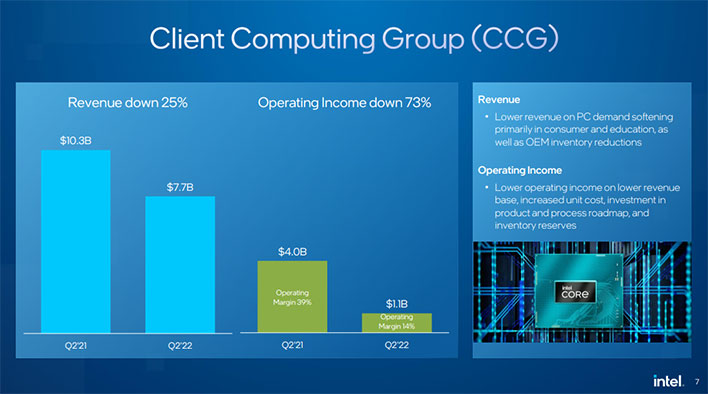Intel CEO Laments Execution Issues As Chip Juggernaut Posts Abysmal Earnings Loss

Aside from death and taxes, one thing we could typically count on is that come hell or high water, Intel would post gains in each and every one of its earnings reports. That's been the case for decades...until now. Amid a challenging economic environment (for a number of reasons), Intel reported a 22 percent year-over-year decline in revenue for the second quarter of 2022, en route to a $500 million loss.
Posting a loss is very much uncharacteristic of Intel these days, and has been for a very long time. Decreases in spending, fallout from the pandemic, Russia's war with Ukraine, and organizations perhaps delaying upgrades until new chip architectures arrive all played a roll. But so did Intel's own stumbles, and company CEO Pat Gelsinger didn't shy away from acknowledging that as a factor.
"This quarter’s results were below the standards we have set for the company and our shareholders. We must and will do better. The sudden and rapid decline in economic activity was the largest driver, but the shortfall also reflects our own execution issues," said Pat Gelsinger, Intel CEO. "We are being responsive to changing business conditions, working closely with our customers while remaining laser-focused on our strategy and long-term opportunities. We are embracing this challenging environment to accelerate our transformation."
Gelsinger returned to Intel in February 2021 to replace Bob Swan as CEO. It's not fair to say Intel was in shambles at the time, but its struggles to execute at the 10-nanometer level were well documented, and it allowed AMD to reestablish itself as a performance competitor with its Zen architecture.
Since taking over, Gelsinger has put into motion and aggressive IDM 2.0 strategy and promised to regain process leadership. It's also recovered somewhat from earlier stumbles with the release of Alder Lake, a capable hybrid chip architecture, and is about release Raptor Lake before moving on to its next node shrink. Intel's roadmap looks pretty good these days.
Even so, Intel must now recover from a rather abysmal quarter. Compared to the same three-month period a year ago, Intel posted losses of 25 percent to its Client Computing Group and 16 percent to its high-margin Datacenter and AI Group. Intel Found Services (IFS) saw its biggest decline, in terms of percentage, falling 54 percent year-over-year.
It wasn't all bad news, though. Part of this is the pain Intel has to go through for its fabrication build outs. The company has invested billions of dollars into new and upgraded chip manufacturing sites, including one in Ohio that's in limbo barring what happens with the US CHIPS Act.
Intel also said it made "significant progress" on its ramp of Intel 7 during the quarter, which is shipping in aggregate over 35 million units, and expects Intel 4 to be ready for volume production this year. Additionally, Intel reiterated that it's at or ahead of schedule for Intel 3, 20A, and 18A.
It's also worth noting that Intel recently struck a major manufacturing deal with MediaTek to produce chips for a range of smart edge devices. So there's reason to be optimistic about Intel's long-term outlook, despite its rough quarterly earnings report. In the meantime, shares of Intel are down nearly 11 percent this morning as investors react to the numbers.


